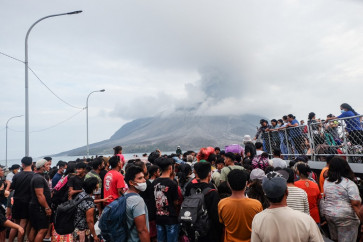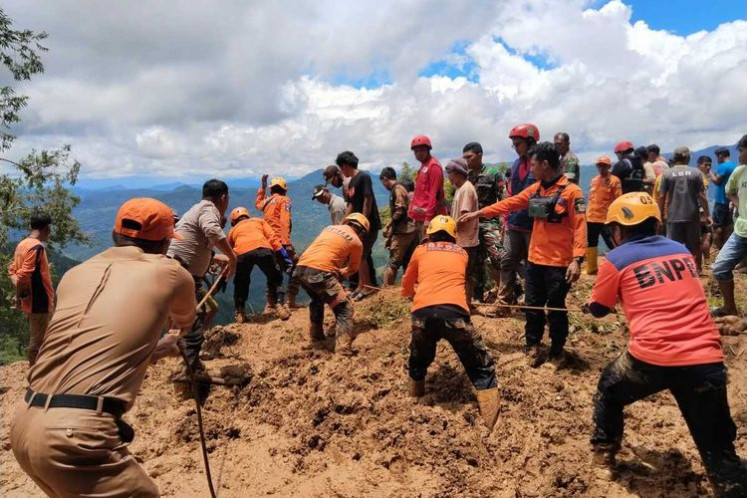Exploring Ubud's nature-rich countryside
Work and culture: A member of COMO Shambhala Estate's guided trekking tour takes a picture of farmers working in rice fields in Melinggih Kelod village outside Ubud, Bali
Change Size
 Work and culture: A member of COMO Shambhala Estate's guided trekking tour takes a picture of farmers working in rice fields in Melinggih Kelod village outside Ubud, Bali. (thejakartapost.com/Novani Nugrahani) (thejakartapost.com/Novani Nugrahani)
Work and culture: A member of COMO Shambhala Estate's guided trekking tour takes a picture of farmers working in rice fields in Melinggih Kelod village outside Ubud, Bali. (thejakartapost.com/Novani Nugrahani) (thejakartapost.com/Novani Nugrahani)
W
span class="inline inline-center">Work and culture: A member of COMO Shambhala Estate's guided trekking tour takes a picture of farmers working in rice fields in Melinggih Kelod village outside Ubud, Bali. (thejakartapost.com/Novani Nugrahani)
At 7:30 a.m. in Ubud, Bali, the sun's golden rays were still peeking sheepishly through the tree branches of the tropical rainforest surrounding wellness resort COMO Shambhala Estate.
But Diana, the estate staff member dedicated to assist me during my stay, was already knocking on my villa's door.
Diana smiled politely when I answered the door. She then escorted me to an electric buggy and drove me to the activity office near the resort's entrance area. A couple of other guests had already gathered there by the time I arrived.
Gede, the estate staff member acting as a tour guide for us that morning, introduced himself prior to explaining about the trek on which we were about to depart.
The rice field trek, one of the complementary activities provided by COMO Shambhala Estate, consists of a light trekking tour around Melinggih Kelod village, near the property's location.
'The trekking activity will take around two hours. We will walk pass through Balinese villages where you can take in the beauty of Ubud rice terraces and distant volcanoes in the idyllic scenery of Melinggih Kelod village,' Gede told us eager explorers.
Gede also reminded all trekkers that Balinese people usually did not keep their dogs in cages but assured us not to worry and keep on walking if the dogs barked at us.
We started our trail through a nearby village. Gede kept an easy and enjoyable pace, allowing all participants to take in the beautiful scenery without running out of breath. It turned out that he was born and raised in Melinggih Kelod ' unsurprising then that he had such fluent knowledge of the village's neighborhood.
As we were passing some Balinese houses, Gede explained how a typical Balinese home took the form of a compound of separate pavilions that served different functions instead of consisting of one single large house.
'Each house has its own family shrine for its members to pray at. Most of the houses are owned by local rice farmers and thus have their own traditional rice barns in the front yard,' said Gede.
Constructed based on the Hindu Tri Hata Karana belief that emphasizes a three-way harmonious relationship between human beings, nature and God, a Balinese house's grounds are never heavily altered, reflecting unity with the earth.
Gede explained that customarily, a Balinese house was inhabited by more than one family since usually it is bequeathed from one generation to the next and never intended to be sold.
Being a local villager himself, who spend his spare time working in rice fields, Gede asked me if Jakartan children still lived with their parents after marriage, as in Bali.
I could barely hide my smile upon hearing such an innocent question from Gede. I gave my best answer to explain that many Jakartans did indeed still live with their parents after marriage; not for cultural reasons, but rather as a result of the capital's sky-rocketing land and property prices.
Eventually we left the paved pathways and entered shallow grassy paths among rice fields. As we passed female farmers planting rice seeds in the wet soil, they smiled shyly at the camera when one of the estate's guests asked for permission to take their pictures.
Gede pointed to a small pura (temple), commonly found in rice fields. 'This building here serves as a kind of market where farmers sell their fresh crop yields to buyers. The building has one pillar in the middle, reflecting a balanced scale,' said Gede.
On our way back to the resort, we also came across a group of tourists who were about to go whitewater rafting on the Ayung River, Bali's longest.
For more adventurous guests, there are many other trails they can take directly from the resort. We finished ours at around 10 a.m., me with a peckish feeling in my stomach, right on time for a well-earned breakfast. (kes)









